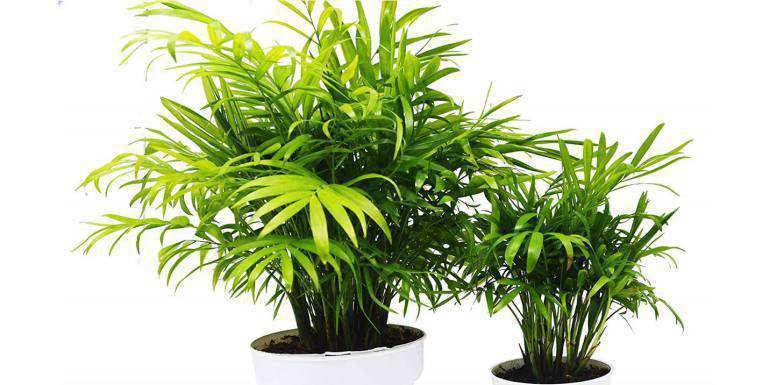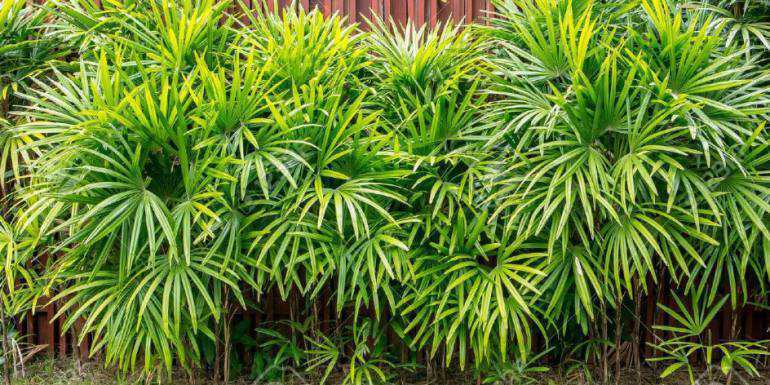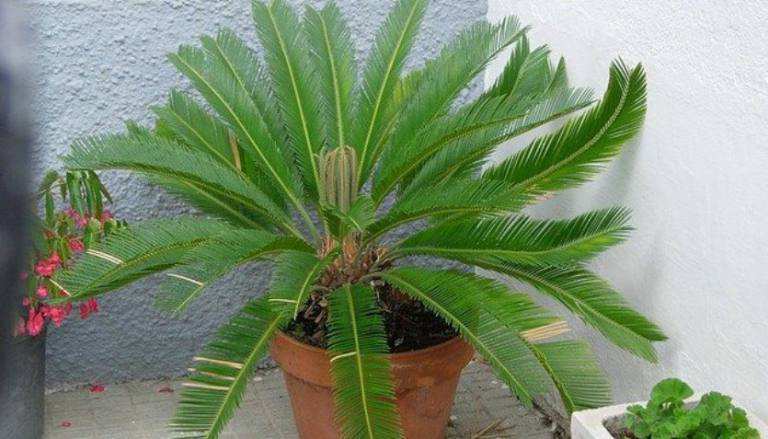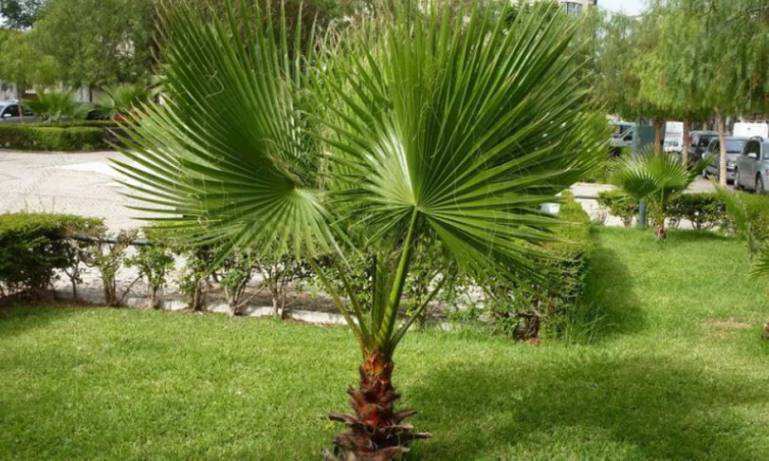What are palms
Palms are perennial tropical and subtropical flowering plants that belong to the family Arecaceae. They grow as shrubs, trees, climbers or stemless plants with the term palm tree used to refer to those that have stems.
There are many varieties with various uses. These uses are associated with specific varieties. For instance, there those used for palm oil or wine, for coconuts, as a vegetable salad, in making dyes, for medicinal purpose, vanish, carnauba wax, basketry, weaving, thatching, and as ornamental, landscaping and houseplants.
We will not go into details on the various varieties and their uses. Instead, we will be focusing on a few common ones and discuss their safety to your kitties, i.e., are they safe, toxic or poisonous to your cats and kittens?
Finally, not all plants that bear the name this name belong to the family Arecaceae or Palmae. Some are totally different.
1. Is majesty palm safe for cats?

Scientifically known as Ravenea rivularis this variety is a common houseplant cultivated and sold mainly in subtropical and tropical regions. It resembles the Queen’s palm. Although you will find it marketed as a house or pot plant, it can grow up to 30 meters tall.
Being popular, you will definitely be curious to know whether it is toxic or safe to cats? Is this Ravenea poisonous or dangerous to kitties
The good news is that it is majesty palm is not toxic, poisonous or harmful to cats, dogs, or horses. In fact, it is one of the indoor palms safe for cats and joins ranks with other cats safe indoor plants such as Kimberly queen and bird’s nest ferns, fittonia, bunny cactus, among others.
While it is not toxic, if your feline eats a lot of its leaves, it might present digestion problems. However, these pets usually nibble only a small amount of plants. Therefore, you do not have to be worried if you see your kitty eating it.
2. Is parlor palm toxic to cats or safe?

Scientifically known as Chamaedorea elegans, the parlor (parlour British) or Neanthe Bella palm is one of the most popular and commonly sold houseplants worldwide. It is also a common ornamental landscaping plant.
Chamaedorea elegans is native to Southern Mexico and it grows into a small tree and can be described as “a woody, rhizomatous shrub-like plant with numerous densely arranged reed-like or bamboo, slender stems, it is found in tropical areas, growing to 2–3 m,” notes Wikipedia.
Its odorous flowers are often yellow, light yellow or orange-red and on a few occasions, you may notice pea-sized berries after flowering has occurred.
Is it safe for cats? Yes. The parlor palm is safe for cats. i.e., it not poisonous to cats, dogs or horses.
3. Is areca palm safe for cats or toxic?

Dypsis or Chrysalidocarpus lutescens commonly known as Areca, golden cane, golden feather, yellow or butterfly palm is another popular garden ornamental plant especially in the tropical and subtropical areas as well as an indoor houseplant in many homes.
Native to the Philippines, South India, and Madagascar, this ornamental plant can grow up to 6-12 meters tall and its base grows several stems.
Is it poisonous to cats? No. It is not poisonous or toxic to cats, dogs, and horses. In fact, it is one of the cat-friendly palms. Do not be worried if you see your feline or canine friend nibbling it if you have it in your garden or as an indoor plant.
However, since plant material is not part of the key component of felines, should they consume excessive amounts, something that rarely happens as it can cause stomach upsets, diarrhea, and vomiting.
4. Ponytail palm and cats

Beaucarnea recurvata, often referred to as ponytail, bottle or elephant’s food palm is one of the family Asparagaceae plant native to Eastern Mexico’s Veracruz, Tamaulipas, and San Luis Potosi. Contrary to what its names suggest, it does not belong to the family Palmae or Arecaceae.
This ornamental plant can grow up to 16 feet. Wikipedia notes that it has a “single palm-like stem produces terminal tufts of strap-shaped, recurved leathery leaves, sometimes hair lock-shaped in the ends.” This plant flowers after 10 years with branched inflorescence of small white flowers.
In dry-frost free regions, Beaucarnea recurvata makes a great houseplant that can be moved out of the house whenever necessary.
Is it toxic to cats? No. ponytail palm is not poisonous to cats, i.e., it is safe or ok for cats, dogs, and horses.
Therefore, you can have it or other houseplants such as Gloxinia, African Violet, baby tears, spider, Calathea, friendship plant, orchid, among many others which are safe to these pets.
5. Is bamboo palm safe or toxic to cats?

Chamaedorea seifrizii also known as bamboo or reed palm is a type of small-sized plant that belongs to the family Arecaceae that grows up to about 7 feet tall. It is native to Mexico, Honduras, Guatemala, Florida, and Belize.
To identify it, it features “long bamboo-like canes. The canes grow to form a dense cluster of fronds with dark green to grey leave,“ as Palmpedia.net describes it.
This garden, as well as a houseplant, is often confused with Chamaedorea microspadix but the two are not one and the same thing.
Is bamboo palm poisonous to cats? No. It is not poisonous to cats or dogs. You can add it to the list of cat-safe house and garden plants.
6. Is cat palm cat-safe?

Commonly known as cat, cascade, cataract palm, the Chamaedorea cataractarum is a small fluffy clustering plant native to Mexico and closely resembles the Dypsis lutescens but has feathery fronds on its green stems while Dypsis lutescens has golden yellow ones.
It grows up to 6 feet tall and requires a tropical environment to thrive well. Its thin shoots, dark leaves that are glossy makes it commonly sought for house and landscaping.
Is cat palm toxic to cats? No. It is not toxic or poisonous to kitties. In fact, according to ASPCA, all plants that belong to the genus Chamaedorea are non-toxic to not only cats but also dogs and horses.
7. Kentia palm and cats

Native to Lord Howe Island in Australia but cultivated in other parts of the world including in the Hawaiian Islands, the Howea forsteriana, kentia, Forster sentry, paradise or thatch palm is a popular garden and houseplant with wide leaves (fonds).
Although it is slow-growing and can grow up to 12 meters. This means you will need to trim it if you have it as an indoor ornamental plant.
It closely resembles the Howea belmoreana (curly or Belmore sentry palm) but has arching foliage while the Howea belmoreana’s foliage is shorter and erect.
Is kentia palm safe for cats? Yes. It is safe for cats as well as dogs. Therefore, if you love any of these two varieties, you can go ahead and have them since they will not be of any harm to these pets.
8. Pygmy date palm

Phoenix roebelenii, miniature, dwarf date palm or robellini is a popular garden ornamental plant grown in tropical and subtropical regions. In cooler areas, it can be grown as a houseplant under glass.
Phoenix roebelenii is a slow-growing, small to medium in size plant and has sweet or sugary fruit pulps and curved leaves.
Is dwarf date palm toxic to cats? No. It is not toxic to felines, canines, and horses. This makes it an ideal ornamental house and garden plant.
9. Livistona rotundifolia

Livistona rotundifolia, table, footstool, java fan or fan palm is a “very attractive and elegant palm with large, shiny, fan-shaped leaves,” as Hortology.co.uk notes. It native to Malaysia, Java, and the Moluccas in South East Asia and makes a good houseplant, i.e., it will add tropical green charm.
Like most other types, the Livistona rotundifolia is safe for cats and dogs. Similarly, the Livistona chinensis, the Chinese fan or fountain palm is also safe for these pets.
10. Sago palms and cats – Cycas revoluta

Cycas revoluta, also known with common names such as king sago, Sotetsu, sago cycad, sago or Japanese sago palm is an ornamental plant native to the Ryukyu Islands and other parts of Southern Japan.
So as not to confuse it, this plant does not belong to the Family Palmae but rather the family Cycadaceae. The only similarity or relation being these two families is that both are seed-bearing plants.
Is sago palm poisonous to cats? Yes. Its leaves can “cause severe damage to the liver, the damage of which can potentially lead to death when the plant has been ingested by a cat,” notes PetMD.
Common symptoms of the poisoning include vomiting, blood-stained feces, bloody diarrhea, increase urination and thirst, depression, circling, seizures and paralysis, coma and death.
Therefore, if you have it, ensure your kitties cannot access it. Alternatively, go for other ornamental plants that are safe to your kitties.
11. Lady’s palm

Rhapis excelsa, lady or broadleaf lady palm medium-size ornamental plant (grows up to 4 meters tall) native to Taiwan and Southern China. It often has multiple stems whose diameters can is about 30 millimeters.
Is lady palm toxic to cats? No. It is not to kitties or dogs. You can have it as an indoor plant or have it in your garden.
12. Trachycarpus fortunei

Trachycarpus fortunei (Chusan, Chinese windmill or windmill palm) native to Japan, Myanmar, China, and India. It is not toxic to felines or canines.
Conclusion
From the above discussion, it is clear that true palm trees including their stem and leaves are not toxic to cats and dogs. This makes them a good option for ornamental indoor or outdoor plants.
If you have various pets including cats dogs, rabbits, hamsters, and so on, you should always be mindful of the garden, yard, and houseplants you have. Avoid any that are poisonous or ensure you limit access to them whenever it is possible.
